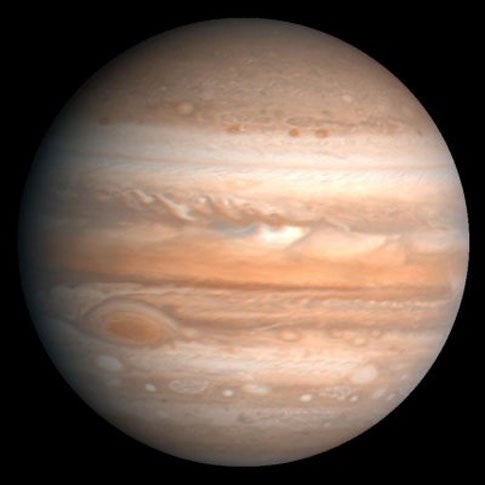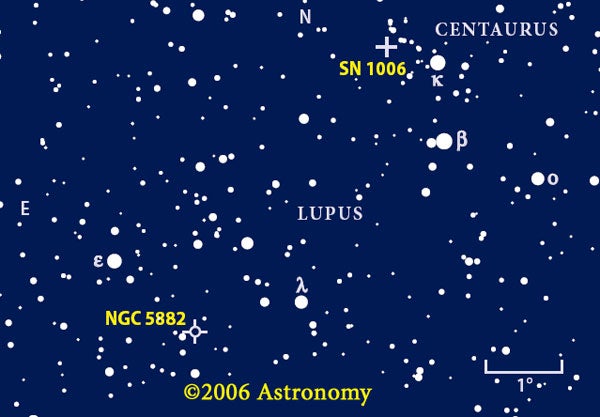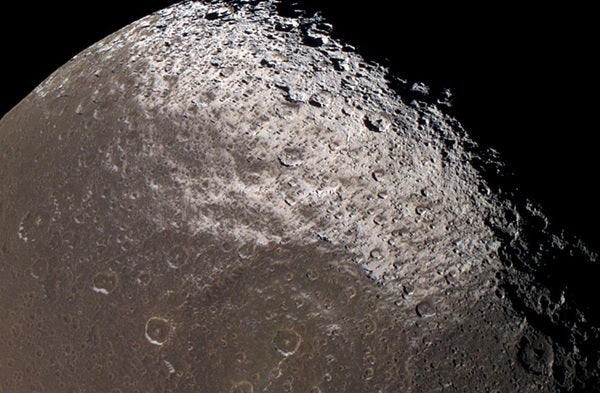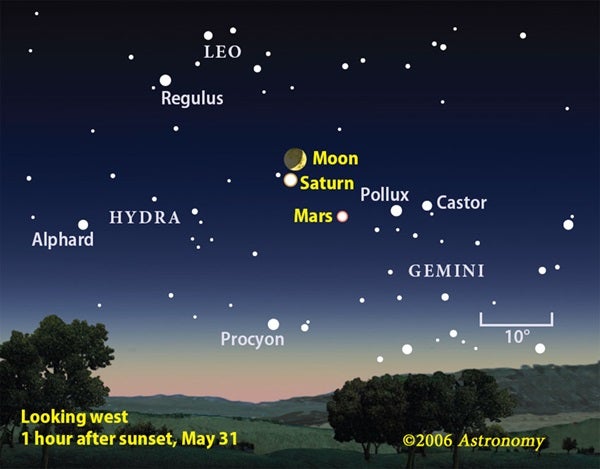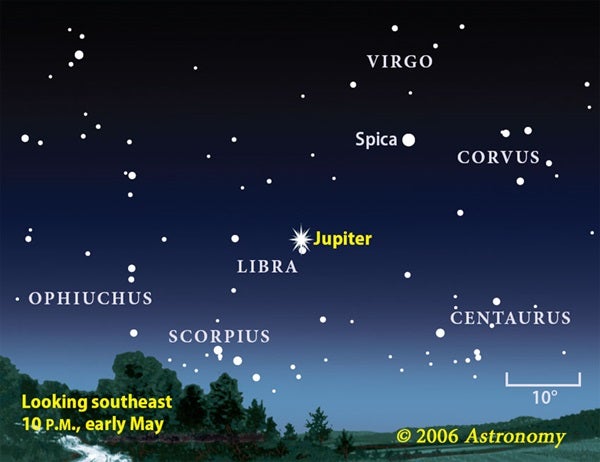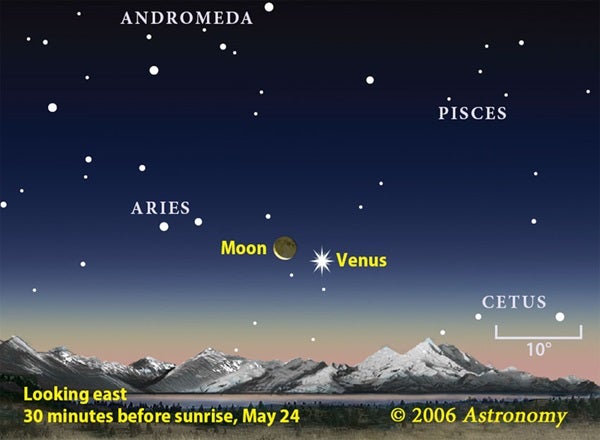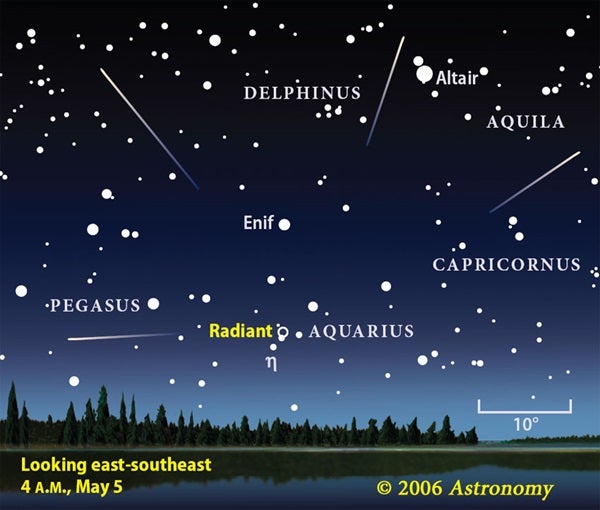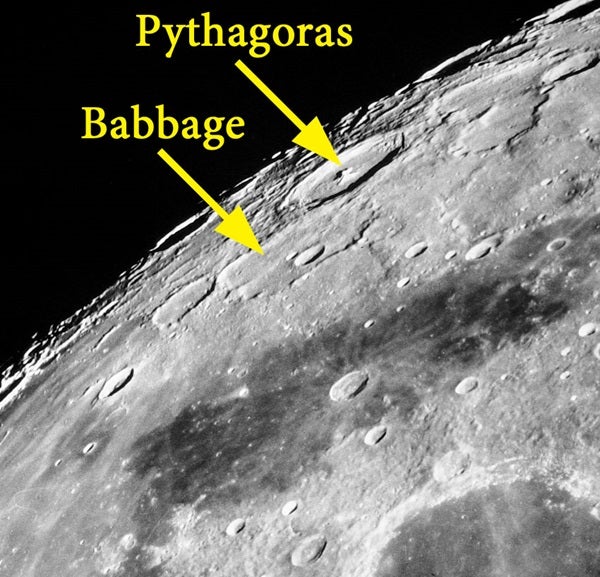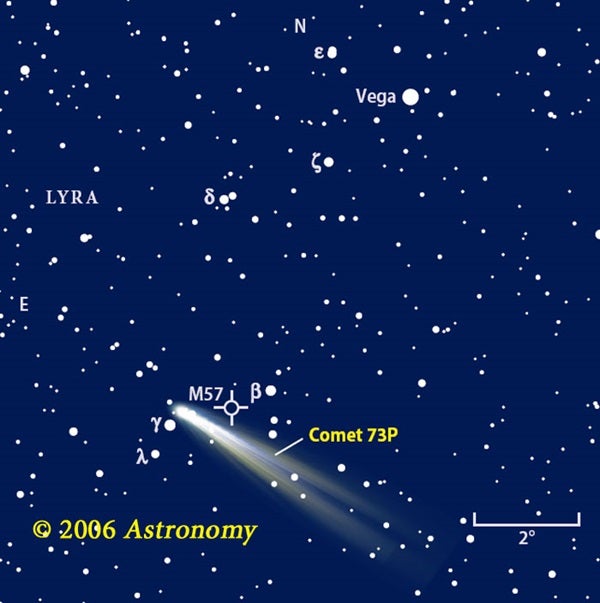What a wonder to behold. Jupiter appears as its own world even through the smallest telescope. Up to four white dots flank the bright disk. These are Io, Europa, Ganymede, and Callisto — the large moons discovered by Galileo in 1610. During the course of a night, you can watch them shift position in a delicate orbital ballet.
At higher magnification, Jupiter’s glaring white disk becomes more subdued. Two large purple-brown stripes oriented along the line of the moons stand out. With patience and experience, you’ll see more of these huge cloud systems. If you’re lucky, a black dot will transit the disk for a couple of hours — a jovian moon’s shadow cast on the cloud tops. Late evening and early morning views of Jupiter are best, once the planet has climbed above the worst turbulence in Earth’s lower atmosphere.
As great as Jupiter is, don’t miss Saturn. The magnificent ringed planet lies halfway to the zenith in the western sky as night falls. In a couple of months, twilight will consume it. Look for two or three pinpoints nearby — Saturn’s brightest moons. Because they lie about twice as far away from Earth as Jupiter’s Galilean moons, Titan and Rhea appear considerably fainter.
A fragment of Comet 73P/Schwassmann-Wachmann 3 should pass within 7 million miles of Earth May 12. This likely will be the comet’s last revolution around the Sun. If we’re lucky, it will flare to 2nd magnitude before diffusing into space dust. Although this may sound bright, it’s what we would see if all of its light were concentrated into a point. Chances are, the comet will display a diffuse halo more than twice the Moon’s apparent size, which could render it invisible from the city.
Grab your binoculars and head to the country in late April or the first few nights of May. The comet will hang low in the northeast, to the right of the bright star Vega. Unfortunately, 73P’s closest approach to Earth happens right when the Full Moon whitewashes the sky.
Speaking of primordial snowballs, dust from Comet Halley will burn up in Earth’s atmosphere during the annual Eta Aquarid meteor shower. The shower’s peak occurs Thursday night, May 4/5, when an observer under a dark sky should see a “shooting star” every few minutes.
Avid skywatchers continue to follow Mars. The fading orange light hangs just left of a crescent Moon as May opens. Although Mars remains prominent to naked eyes, a telescope shows little but a rust-colored surface because the planet lies so far away. With binoculars, follow Mars as it closes in on Omega (ω) Geminorum; it grazes past the star May 7.
As the Moon waxes in early May, it sweeps above Saturn on the 3rd. At full phase, it then appears below Jupiter both May 11 and 12. A couple of weeks later, the waning crescent Moon joins blazing Venus at dawn. Venus currently lies on the opposite side of the solar system from us and shows a shrinking gibbous disk to telescope owners.
A thousand years ago this month, a star exploded in the constellation Lupus. Credible eyewitness reports tell how this “guest star” could be seen easily during daylight. It shone with the light of a half-lit Moon or more. Turn to page 57 to find out what may await us when the next supernova lights up our corner of the galaxy.
Brightest star ever seen
A thousand years ago this month, a star in the constellation Lupus the Wolf ripped itself apart in a cataclysmic explosion. The supernova peaked at an incredible brightness of around magnitude –7.5, some 15 times brighter than brilliant Venus at its best. Skywatchers easily saw it in broad daylight and followed it for more than 2 years at night. From the Northern Hemisphere, Lupus lies near the southern horizon around midnight this time of year.
What might the next big one look like? We know the Milky Way is overdue for a supernova — they occur, on average, once a century, and the last one seen occurred more than 400 years ago. The best candidate star we know is Eta Carinae, a massive star tucked inside the brightest nebula visible from Earth. But a type Ia supernova could erupt in a currently nondescript region of sky.
A supernova gleaming at magnitude –7.5 would stun the world, even today. It would appear conspicuous in daylight. At night, its light would dazzle. Perhaps its most striking characteristic would be twinkling. Neither Venus, which peaks around magnitude –4.5, nor the brightest flares from Iridium satellites, which rival our hypothetical supernova, twinkles. Their steady glows arise because these objects appear large enough that turbulence in Earth’s atmosphere smears the image. But with a point source like a supernova, every atmospheric undulation shifts the distant object’s light back and forth, making it twinkle.
A bright guest star would cast shadows and shine bright enough to make reading star charts a snap without artificial illumination. The supernova’s months-long brilliance would ruin dark adaption, so deep-sky observers might have to concentrate on brighter targets.
Of course, some may interpret the supernova as a portent of doom and sign of apocalypse. However, backyard observers will be there with telescopes to share the beauty and wonder of the universe with all who venture outside and look up.
When a massive star explodes, the conflagration can light up a whole galaxy. But for a Sun-like star, the end is more gentle. Instead of an explosion, the star puffs off its outer layers. For a few thousand years, the ejected gas glows as a beautiful planetary nebula.
One of the most colorful planetaries in the sky lies just a few degrees southeast of the site of Supernova 1006. NGC 5882 shows a distinct blue-green hue in 6-inch and larger telescopes. The planetary appears as a circular shell 15″ across. A faint halo, approximately 5′ in diameter, surrounds the shell, but it glows too faintly to see with backyard scopes.
On May 3, the waxing crescent Moon will guide you to the next planet, Saturn. Both lie high in the west-southwest at the end of twilight, with Saturn 5° left of the Moon. Saturn remains on view until early morning all month.
The ringed planet crawls across the constellation Cancer the Crab and creeps closer to the Beehive star cluster (M44) for a final time this year. On May 31, it stands less than a Moon-width southwest of the cluster. The two make a fine sight in binoculars. Meanwhile, a 5-day-old crescent Moon stands watch over the pair, some 3° to the northeast.
Saturn’s elegant rings span 40″ and present a fine view through any telescope. Expect to see the dark gap of the Cassini Division separating the outer A ring from the brighter B ring. The planet’s disk measures 18″ across and shows a dark equatorial belt along with more subtle, dusky shadings.
You’ll easily spy Saturn’s biggest and brightest moon, Titan, lurking near the planet. It passes due north of Saturn May 8 and 24 and due south May 16. Intriguing Iapetus brightens during May as it heads toward its greatest western elongation May 29. On this late spring evening, it shines at its brightest, magnitude 10.1. The moon’s dual personality — it appears significantly brighter when west of Saturn — arises because it has one bright and one dark hemisphere that reflect vastly different amounts of sunlight.
The best time to view Jupiter is near local midnight (1 a.m. local daylight time), when the giant planet stands highest above the southern horizon. A small scope at about 75x readily shows two dusky belts spanning Jupiter’s equatorial region. The planet’s disk measures 44.7″ across at opposition. Notice its polar diameter spans 3″ less, which gives Jupiter a distinct flattened appearance. This comes about because of its fast rotation — the planet’s gravity can’t hold the bulging equatorial regions as tightly.
Moving in line with Jupiter’s equator are the four bright Galilean moons: Io, Europa, Ganymede, and Callisto. Each moon appears as a bright “star” adjacent to Jupiter and moves relative to every other hour to hour, and night to night.
If you view the planet for only a minute, the main dusky belts may be all you see. Watch for a longer period, and your eye will attune to Jupiter’s brilliant disk. More subtle features — festoons, wisps, dark and bright spots — then will come into view. These features whisk around Jupiter in a period between 9 hours and 50 minutes and 9 hours and 55 minutes. The exact rotation period depends on latitude; higher latitudes rotate slower than lower ones. Jupiter doesn’t rotate as a solid object like Earth does. Along the boundaries separating different rotation speeds, dramatic turbulence results. This is what creates the fascinating patterns along the edges of its dark belts and light zones.
Let’s now turn from the biggest planet to the biggest planetary challenge: spotting Pluto. The most distant planet glows dimly at magnitude 13.9 among the background stars of Serpens Cauda. Use the 3.5-magnitude star Xi (ξ) Serpentis as a guide or, if you’re more familiar with deep-sky objects, the bright open cluster M23 in Sagittarius. Pluto lies 1.7° east of Xi and about 5° northwest of M23. Even though an 8-inch telescope can bring the dim planet into view, a 10-inch or larger scope makes direct viewing easier. You’ll need an accurate star chart that shows stars down to 14th magnitude and a couple of clear nights to confirm a Pluto sighting. Sketch or image the field the first night, then return to see which faint object moved in that time, betraying its planetary identity.
Neptune lies closer to the Sun than Pluto. Combined with its greater girth, the Sun’s eighth planet glows more than 100 times brighter, at magnitude 7.9. In mid-May, binoculars will reveal Neptune by 4 a.m. local daylight time, about 2 hours after it rises. You’ll find it floating in Capricornus the Sea Goat 2° northeast of Iota (ι) Capricorni. Its small disk, just 2.3″ in diameter, looks distinctively non-stellar. And its blue-gray hue appears noticeable even in small scopes.
As dawn breaks, Uranus sits in the same binocular field as Lambda (λ) Aquarii. In early May, the planet lies nearly 15° above the east-southeastern horizon at 5 a.m. local daylight time. Look for what appears to be a double star with 6th-magnitude components — one object is the star 81 Aquarii, the other is Uranus. By the 18th, Uranus forms a nice right-angle triangle with the stars 81 and 82 Aquarii. The group then stands 25° high at 5 a.m.
as it moves through Pisces. In mid-May, the planet’s shrinking disk measures 16″ across, while its waxing phase appears 71-percent lit.
Although Venus reaches aphelion, its greatest orbital distance from the Sun, May 17, this doesn’t improve the planet’s visibility. The shallow angle of the ecliptic to the horizon keeps the “morning star” hugging the horizon. A waning crescent Moon passes 4° from Venus May 24 and creates a beautiful early morning spectacle.
Mercury makes a quick swing around the Sun during May. It begins the month west of the Sun and appears briefly above the eastern horizon as the dawn sky brightens. On the 1st, it shines at magnitude –0.6 and rises about 30 minutes before the Sun.
It rapidly sinks out of sight until late May, when it reappears in the evening sky. Look for it 45 minutes after sunset. On the 28th, Mercury lies 10° below a thin crescent Moon. And on the 30th, the planet lies between the two stars that mark the horns of Taurus the Bull. Mercury then shines at magnitude –1.2, so it’s noticeably brighter than the stars.
Virgo’s brightest star, Spica, reappears from behind the Moon’s limb May 10 about 45 minutes before the Sun sets. Only observers along the United States’ eastern seaboard can see this daylight event. Visit the web site of the International Occultation Timing Association for details for your specific location.
Halley’s children return
Two annual meteor showers derive from dust released by Comet 1P/Halley during its countless trips through the inner solar system. The first arrives in early May. The Eta Aquarid shower remains active from April 19 through May 28, but you’ll want to observe as close to the May 4/5 peak as you can. This year, the First Quarter Moon doesn’t interfere with the prime viewing hours before dawn on the 5th.
The number of meteors you see depends on the radiant’s altitude. If it appeared overhead (the so-called zenithal hourly rate), you’d see nearly one meteor per minute. The actual, lower radiant reduces this number noticeably. Still, May’s warm weather makes the Eta Aquarids among the year’s best-observed showers. To see the most meteors, observe from a dark-sky site.
The second meteor shower spawned by Comet Halley arrives in October. The Orionids don’t produce as many meteors as the Eta Aquarids, but the radiant climbs higher, and they benefit this year by peaking at New Moon.
Near the Moon’s northwestern limb, you’ll find two craters that are rarely seen well. During a favorable libration, however, Babbage and Pythagoras tilt a few extra degrees toward us, offering a unique view of these craters. Such conditions occur beginning May 11 and 12, near Full Moon when the Sun rises over the region. Libration will favor views of the northwestern limb for the next 10 days.
To find this region, start with the prominent crater Plato just off the northern shore of Mare Imbrium. Move north to the finger-like Mare Frigoris, and follow it to its western end. Then, shift your gaze toward the limb, where you’ll first see the distinctive classical crater Pythagoras. Babbage lies just southeast of Pythagoras.
Pythagoras spans 81 miles and shows a foreshortened outline typical of craters near the lunar limb. You will get a nice view of the crater’s floor, however. Look for the mile-high central mountain, as well as terracing on the crater’s prominent, 3-mile-high walls.
Babbage is an 89-mile-wide walled plain. Its walls are irregular and nestle right up to Pythagoras’ southern edge. There’s a fresh, sharp-rimmed crater on Babbage’s floor, with a smaller crater next to it. Can you spot both of them?
A comet’s swan song
Neil Young wasn’t referring to comets when he sang “It’s better to burn out than to fade away.” But the sentiment certainly rings true when it comes to observing comets. Astronomers are guardedly optimistic that Comet 73P/Schwassmann-Wachmann 3 will brighten to 2nd magnitude this month, which should be good enough to see from a city park with the naked eye. Our relative positions in space make this a show best viewed after midnight.
Don’t miss the chance to see this bright fuzzball from a dark-sky location. Small comets like 73P often have a small core surrounded by a huge, faint halo. From the city, the central knot may be all that’s visible. The halo could extend more than twice the Moon’s apparent size, but it likely will be visible only from the country. Make sure you bring binoculars — they should provide the most impressive view.
Comet 73P’s fragment C will be well-placed for evening skywatchers only until the end of April; unfortunately, before it reaches its peak. During the first week of May, you should delay observing it until the Moon sets. On the 1st, that’s around midnight; by the 4th, we’re talking 2 A.M. The comet passes close to the Ring Nebula (M57) in Lyra May 8, but the Moon-free observing window comes just as dawn breaks.
After that, things go from bad to worse. The Moon waxes brighter, the comet rises later, and the two head for the same area of sky. Despite deteriorating conditions, you should take every opportunity to observe the comet because it could flare anytime. The Moon passes just 6° away May 22. The comet continues to approach the Sun, to the point where it will be visible only during morning twilight. Assuming there’s anything left to see, observers in the Southern Hemisphere will be favored then.
In the event Comet 73P/Schwassmann-Wachmann 3 dissolves sooner than expected, another fuzzball should be worth a look. Comet C/2004 B1 (LINEAR) should glow around 10th magnitude as it crosses the Milky Way in Aquila the Eagle. On the morning of May 9, it will pair up with the ghostly disk of the planetary nebula NGC 6781.
To get a decent view of C/2004 B1, observe from a dark sky. During the first week of May, this means watching before dawn. After the 15th, it climbs reasonably high by midnight, when it sits above Altair in the east.

